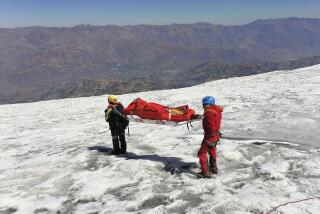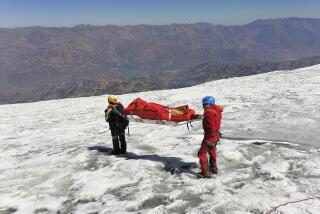Andes Climbers Find Frozen Body, Possible Inca Shrine
- Share via
MENDOZA, Argentina — Climbers said Friday that they have discovered a frozen human body in what appears to be an ancient Inca shrine high on the slopes of the hemisphere’s highest mountain.
“We don’t know exactly what it is. An expedition of scientists is going up next week to find out,” said Felix Fellinger, president of the local mountaineering club in this western Argentine city in the Andean foothills.
The cadaver was discovered last week inside one of two stone enclosures built against the base of a cliff at about 16,500 feet on the southwest slope of Mt. Aconcagua by a five-man team of climbers from the club, one of them a medical doctor, Fellinger said.
The Argentine climbers had been seeking a new route to the 22,834-foot summit of Aconcagua, which is the highest peak in the Western Hemisphere and a magnet for climbers from around the world at this time of the year. It is summer south of the equator.
“The enclosures looked to the climbers as though they were Inca, but they are mountain climbers, not archeologists,” Fellinger said.
He said the climbers saw the top of the cadaver’s head through the stones and that it was frozen and of great age. They descended to report their find without molesting either the cadaver or the enclosure, he said.
The region of the central Andes and Mt. Aconcagua marked the southernmost extension of the Inca empire in the last seven or eight decades before the arrival of the Spaniards in the early 16th Century.
The frozen and mummified remains of four other Incas in similar enclosures have been found by climbers over the years, the most recent in 1964 on El Toro Mountain in San Juan province north of here.
“Maybe this will support the theory that the Incas, or at least their southernmost kin, practiced what we believe to have been human sacrifices at great altitude,” said Pablo Sacchero, an archeologist at the University of Cuyo here who will climb with next week’s expedition.
The area around the find is permanently frozen and too high for permanent habitation, Sacchero said.
“In the summertime,” he added, “there might have been llama herders, guanaco hunters or perhaps miners living there temporarily. The body itself and what artifacts we find around it will go a long way toward determining how and when he--or she--died.”
The cadaver found in 1964, estimated to be about 400 years old, had been so well preserved by the cold that scientists were able to examine the contents of the stomach and intestines. The other two previous high altitude finds of Inca burial enclosures have come in Peru and Chile.
Fellinger cautioned against overestimating the scientific importance of the new find until the cadaver is examined.
“Aconcagua is full of bodies,” he said. “We don’t know what this one is. There are at least three mountain climbers who have disappeared without trace over the years--a Swiss, an Austrian and a Japanese. It might be one of them. It could also be a herder who took refuge in an Inca enclosure and froze to death. We’ll have to wait and see.”
More to Read
Sign up for Essential California
The most important California stories and recommendations in your inbox every morning.
You may occasionally receive promotional content from the Los Angeles Times.










